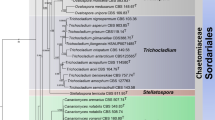Summary
Sixty-seven patients with infections in which the recently proposed speciesActinomyces neuii was involved were observed during a 4 1/2-year period. Microbiological as well as clinical features of the patients are presented.A. neuii does not cause typical actinomycosis and is detected most often in material from abscesses or infected atheromas. One case of a fatal septicemia caused byA. neuii in a non-immunocompromised host was seen. Antimicrobial susceptibility patterns ofA. neuii isolates and results of various treatment regimens are discussed.
Zusammenfassung
Während 4 1/2 Jahren wurden 67 Patienten mit Infektionen, an denen die kürzlich definierte SpeziesActinomyces neuii beteiligt war, beobachtet. Mikrobiologische und klinische Charakteristika dieser Infektionen werden aufgezeigt.A. neuii verursacht nicht das Bild einer klassischen Aktinomykose; er wird am häufigsten bei Patienten mit Abszessen oder infizierten Atheromen gefunden. Der Fall einer durchA. neuii bedingten letal verlaufenden Sepsis bei einer nicht-immunkompromittierten Patientin wird geschildert. Resistenzmuster vonA. neuii-Stämmen und verschiedene Ansätze zur Therapie vonA. neuii-Infektionen werden diskutiert.
Similar content being viewed by others
References
Na'was, T. E., Hollis, D. G., Moss, C. W., Weaver, R. E. Comparison of biochemical, morphologic, and chemical characteristics of Centers for Disease Control fermentative coryneform groups 1, 2, and A-4. J. Clin. Microbiol. 25 (1987) 1354–1358.
Coudron, P. E., Harris, R. C., Vaughan, M. G., Dalton, H. P. Two similar but atypical strains of coryneform group A-4 isolated from patients with endophthalmitis. J. Clin. Microbiol. 22 (1985) 475–477.
Funke, G., Martinetti-Lucchini, G., Pfyffer, G. E., Marchiani, M., von Graevenitz, A. Characteristics of CDC group 1 and group 1-like coryneform bacteria isolated from clinical specimens. J. Clin. Microbiol 31 (1993) 2907–2912.
Funke, G., Stubbs, S., von Graevenitz, A., Collins, M. D. Assignment of human-derived CDC group 1 coryneform bacteria and CDC group 1-like coryneform bacteria to the genusActinomyces asActinomyces neuii subsp.neuii sp. nov., subsp. nov., andActinomyces neuii subsp.anitratus subsp. nov. Int. J. Syst. Bacteriol. 44 (1994) 167–171.
George, W. L. Other infections of skin, soft tissue, and muscle. In:Finegold, S. M., George, W. L. (eds.): Anaerobic infections in humans. Academic Press Inc., San Diego 1989, pp. 485–506.
National Committee for Clinical Laboratory Standards Methods for dilution antimicrobial susceptibility tests for bacteria that grow aerobically — third edition; approved standard. NCCLS document M7-A3. National Committee for Clinical Laboratory Standards, Villanova, 1993.
Schaal, K. P. GenusActinomyces. In:Sneath, P. H. A., Mair, N. S., Sharpe, M. E., andHolt, J. G. (eds.): Bergey's manual of systematic bacteriology, vol. 2. The Williams & Wilkins Co., Baltimore 1986, pp. 1383–1418.
Lerner, P. I. Actinomyces andArachnia species. In:Mandell, G. L., Douglas, R. G., Bennett, J. E. (eds. Principles and practice of infectious diseases. Churchill Livingstone Inc., New York 1990, pp. 1932–1942.
Wüst, J., Martinetti Lucchini, G., Lüthy-Hottenstein, J., Brun, F., Altwegg, M. Isolation of gram-positive rods resembling but clearly distinct fromActinomyces pyogenes from mixed wound infections. J. Clin. Microbiol. 31 (1993) 1127–1135.
Wüst, J., Stubbs, S., Weiss, N., Funke, G., Collins, M. D.: Assignment ofActinomyces pyogenes-like (CDC coryneform group E) bacteria to the genusActinomyces asActinomyces radingae sp. nov. andActinomyces turicensis sp. nov. Lett. Appl. Microbiol. (in press)
von Graevenitz, A., Pünter, V., Gruner, E., Pfyffer, G. E., Funke, G. Identification of coryneform and other gram-positive rods with several methods. APMIS 102 (1994) 381–389.
Author information
Authors and Affiliations
Rights and permissions
About this article
Cite this article
Funke, G., von Graevenitz, A. Infections due toActinomyces neuii (former “CDC coryneform group 1” bacteria). Infection 23, 73–75 (1995). https://doi.org/10.1007/BF01833868
Received:
Accepted:
Issue Date:
DOI: https://doi.org/10.1007/BF01833868




